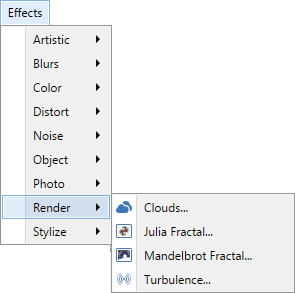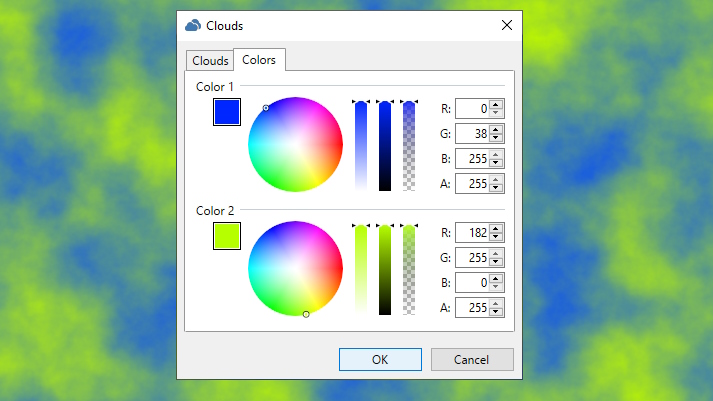Render Effects
This sub-menu contains effects that create entirely new renderings. Effects found in the

Note
The examples on this page show the effects being applied to an entire image. It is easy to restrict the adjustment to a sub-section of the image simply by making a selection. If a selection is active when the effect is run, it will only be applied to the selected region. Areas outside of the active selection will remain unchanged.
Tip
The controls shown in the effect dialogs operate in much the same way; drag the indicator left,
right or in a circular motion (for an angle control).
Typing in a numeric value in the text box or using the up/down arrows beside the text box also
changes the current value.
The keyboard arrow keys can be used to alter the value of a control once it has the focus.
Multiple controls can be used in isolation or combination. If more than one is altered, the
cumulative effect will be shown.
 Clouds
Clouds
This renders a randomized "cloud" effect to the layer or selection. The configuration dialog has a tabbed interface with two tabs. The first tab (Clouds) sets the parameters of the effect:
Example - Effects > Render > Clouds

The second tab (Colors) sets the colorization of the Clouds effect.
The
Example - Effects > Render > Clouds (Colors Tab)

Tip
To render
 Julia Fractal
Julia Fractal
This effect renders a Julia fractal onto the layer or selection.
Note
The colors of this fractal are not configurable from within the effect dialog.
Example -Effects > Render > Julia Fractal

 Mandelbrot Fractal
Mandelbrot Fractal
This effect renders the famous Mandelbrot fractal to the layer or selection.
Note
The colors of the fractal are not configurable from within the effect dialog except via the option to
Checking the ☑
Example - Effects > Render > Mandelbrot Fractal

 Turbulence
Turbulence
The
Note
The colors of
Example - Effects > Render > Turbulence
